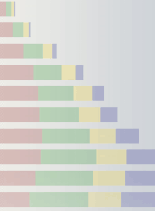A Brief History of International Futures:
International Futures (IFs) has evolved since 1980 through four "generations," with a fifth generation now taking form.
The first generation had deep roots in the world models of the 1970s, including those of the Club of Rome. In particular, IFs drew on the Mesarovic-Pestel or World Integrated Model (Mesarovic and Pestel 1974). The author of IFs had contributed to that project, including the construction of the energy submodel. IFs consciously also drew on the Leontief World Model (Leontief et al. 1977), the Bariloche Foundation’s world model (Herrera et al. 1976), and Systems Analysis Research Unit Model (SARU 1977), following comparative analysis of those models by Hughes (1980). That generation was written in FORTRAN and available for use on main-frame computers through CONDUIT, an educational software distribution center at the University of Iowa. Although the primary use of that and subsequent generations was by students, IFs has always had some policy analysis capability that has appealed to specialists. For example, the U.S. Foreign Service Institute used the first generation of IFs in a mid-career training program.
The second generation of International Futures moved to early microcomputers in 1985, using the DOS platform. It was a very simplified version of the original IFs without regional or country differentiation.
The third generation, first available in 1993, became a full-scale microcomputer model. The third generation improved earlier representations of demographic, energy, and food systems, but added new environmental and socio-political content. It built upon the collaboration of the author with the GLOBUS project, and it adopted the economic submodel of GLOBUS (developed by Dr. Hughes). GLOBUS had been created with the inspiration of Karl Deutsch and under the leadership of Stuart Bremer (1987) at the Wissenschaftszentrum in Berlin.
The third generation has produced three editions/major releases of IFs, each accompanied by a book also called International Futures (Hughes 1993, 1996, 1999). The second edition moved to a Visual Basic platform that allowed a much improved menu-driven interface, running under Windows. The third edition incorporated an early global mapping capability and an initial ability to do cross-sectional and longitudinal data analysis.
The fourth generation has taken shape since early 2000. It has been heavily influenced by the usage of the model in an increasingly policy-analysis mode by several important organizations. First, General Motors commissioned a specialized version of IFs named CoVaTrA (Consumer Values Trends Analysis) with a need for updated and extended demographic modeling and representation of value change. An alliance was established with the World Values Survey, directed by Ronald Inglehart (Inglehart and Welzel 2005), to create that version. Second, the Strategic Assessments Group (SAG) of the Central Intelligence Agency commissioned a specialized version named IFs for SAG. The work involved in preparing that greatly extended and enhanced the socio-political representations of the model, both domestic and international. Third, the European Commission sponsored a project named TERRA which has led to a specialized version named IFs for TERRA. IFs for TERRA work led to enhancements across the model, including improved representation of economic sectors, updated IO matrices and a basic Social Accounting Matrix, GINI and Lorenz curves, and preparing for extended environmental impact representation (drawing upon the Advanced Sustainability Analysis framework of the Finland Futures Research Center).
Throughout this emergence of a fourth generation IFs (incorporating all of the above elements for additional users) there has been also a heavy emphasis on enhanced usability. Ideas from Robert Pestel in the TERRA project led to the creation of a new tree-structure for scenario creation and management. Ideas from Ronald Inglehart led to the development of the Guided Use structure and a somewhat more game-like character within that structure. Inglehart also help arrange funding to support the programming of Guided Use through the European Union Center of the University of Michigan.
The fifth generation of work on the system is now underway and has three major thrusts. The first is continued enhancement of the model itself, including the clearer and more extensive representation of the agent classes and their points of leverage. The desire to make the model a more valuable scenario-testing and policy-analysis tool guides that development. For instance, the further elaboration of the social accounting matrix structure, the development of education and health sub-models, and the substantial redesign of an economic production function with endogenous multifactor productivity are among several development directions.
Second, the project continues to make model interface and usability enhancements. These include a number of specialized displays, such as those to see the social accounting matrices, to display progress towards Millennium Development Goals, to explore poverty at different income levels, and to represent the educational attainment of population cohorts. Mapping and data analysis tools are being strengthened. The ability to drill into selected countries and to explore futures at the state or province level has been added.
The third thrust is the institutionalization of the IFs system via (a) increased accessibility, transparency and openness and (b) broader and deeper connections with other modelers and model users. Large-scale models are often difficult to access, much less to understand and use with confidence. The first step in greatly increasing accessibility to IFs was the sponsorship of the web-based version of the model by the National Intelligence Council in its Project 2020 (NIC 2004). Among the methods that have been developed to make IFs more transparent are creating the ability to access flow charts, equations, and even computer code on demand for a user interested in particular variables/sub-areas of the model. One method the project has explored to make the model more open is the ability to add Vensim (system dynamics) modules and Excel modules to the model. Ultimately, making large-scale models into living tools will require providing general stuctures into which sophisticated users can insert new components in modular form.
Additionally, this includes the building of the Fredrick S. Pardee Center for International Futures, located in Ben Cherrington Hall at the University of Denver. Please visit our IFs News section to keep up on changes.

